|
Thunderstorm Definition
>> A convective shower of rain or snow
accompanied by thunder
Thunder
>> A warning that lightning is near
>> Caused by the explosive expansion of super-heated air due to lightning
The explosive boom that is heard
during a thunderstorm is actually a direct result of the lightning that is seen
moments before. After a bolt of lightning is produced, the air that
surrounds the bolt of lightning is super-heated and expands at an explosive
rate. The expansion of the air away from the bolt of lightning produces
the sound of thunder.
Lightning
>> A discharge of static electricity
that occurs when the difference in electric charge between two points exceeds
the insulating ability of the air
Lightning occurs when the difference
of electric charge between two points builds up to a point where the insulating
properties of the air break down. Once the insulating properties have
broken down, an electric current can be established between the two points.
This electric current is seen as a bolt of lightning.
>> Precipitation Theory
The precipitation theory is one
possible explanation of why lightning occurs. This theory states that the
charge separation in clouds occurs due to the collision of ice crystals within
the cloud. The collision of ice crystals causes negative charge to collect
near the base of the cloud. The separation of charges in a thunderstorm
can be seen in Figure 1 below.
|
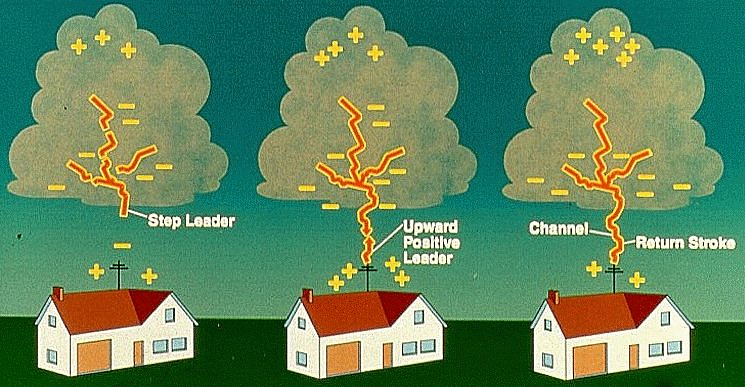 |
|
Figure 1:
The image above shows the charge separation found within a thunderstorm and
how it leads to the formation of lightning. |
>> Lightning Types
There are two primary ways in which
lightning can travel - within the clouds or between the cloud and the ground.
Cloud-to-cloud lightning occurs within the cloud and accounts for 80% of
all lightning occurrences.
Cloud-to-ground (or ground-to-cloud)
lightning, while only accounting for 20% of lightning occurrences, is the type
most widely recognized by the general public. Cloud-to-ground lightning is
responsible for lightning-induced fatalities.
As many people know, cloud-to-ground
lightning strikes the highest exposed objects most frequently. In order to
protect yourself from being struck by lightning, avoid standing in an open field
or under a large and isolated tree. The two different forms of lightning
mentioned above can be seen in Figures 2 and 3 below.
|
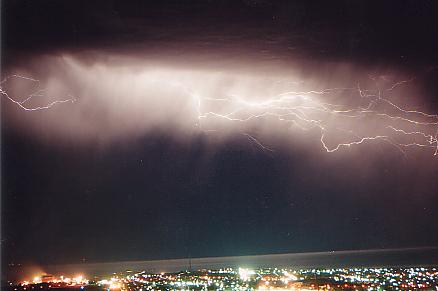 |
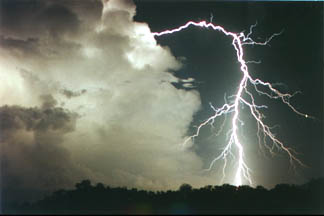 |
|
Figure 2:
The picture above shows a classic example of cloud-to-cloud lightning.
Cloud-to-cloud is the most common lightning observed. |
Figure 3:
The image above shows a typical lightning bolt traveling between the
thunderstorm cloud and the ground. Although less common, cloud-to-ground lightning is
responsible for essentially all lightning-related deaths and injuries. |
>> How far away is it?
The distance to a thunderstorm (actually, it is the
distance to the lightning bolt) can be
easily calculated right from your backyard, assuming you understand a few
important concepts. Since light travels much faster (670,000,000 miles per
hour) than sound does (750 miles per hour), lightning is seen as it happens, but
thunder is delayed. Using this fact, you can find out how far away a
thunderstorm is. To do this, you must keep an eye out for a flash of
lightning. After seeing the lightning, count the seconds until you hear
the first rumble of thunder. For every five seconds that pass, the
lightning is 1 mile farther away.
>> If a person is struck by lightning
If someone happens to be struck by
lightning, they have a better chance to survive if just a few simple facts are
kept in mind. First, and most importantly, people struck by lightning do
NOT hold electric charge and, therefore, they can be safely touched. This allows
proper medical aid to be provided to a lightning strike victim in a timely
manner. In fact, two out of three victims can be saved if the medical
response is prompt.
Air-mass/Non-severe Thunderstorm Development
>> Most occur in the mid to late
afternoon hours
>> Lowest layers of air warmed the most
As mentioned earlier in the semester,
the sun works to directly warm the ground. Through conduction and convection
the ground warms the lowest layers of air the most.
>> Lower atmosphere becomes unstable
and primed for thunderstorm development
If the lower atmosphere is warmed
enough by the ground, that part of the atmosphere becomes unstable and primed for thunderstorm
development. Once the atmosphere is unstable, all that is needed is
something to trigger thunderstorm development.
>> Need something to trigger the thunderstorms
|
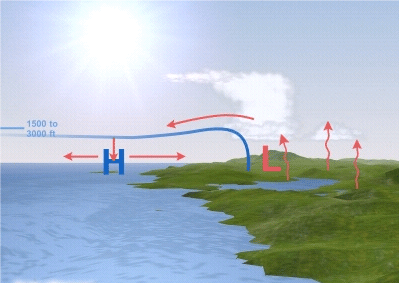 |
|
Figure 4:
The image above illustrates the role of the sea breeze in triggering
thunderstorm development. |
One such thunderstorm trigger is a
sea-breeze. This atmospheric phenomenon occurs when the air over a body of
water remains cooler than the air found over the neighboring land. This
difference in temperature between the two regions causes the wind to blow from
the body of water toward the shoreline. This onshore flow of air brings
cooler air inland. This cooler air eventually works to force the warmer
air upward. This concept can be seen in Figure 4 to the right.
Another thunderstorm trigger is known as an
elevated heat source. In this case, the air just above the
ground warms nearly equally whether on a mountain or the lowlands below, but the higher-elevation
warm air is surrounded by cooler air. Since the warm air is more buoyant
than the surrounding air, it begins to rise.
United States Climatology: Thunderstorm
Frequency
>> Gulf Coast, especially Florida,
has the most thunderstorms
>> Rocky Mountains also have a good amount of thunderstorms (elevated
heat sources)
A map of thunderstorm frequency can be
seen in Figure 5 below.
|
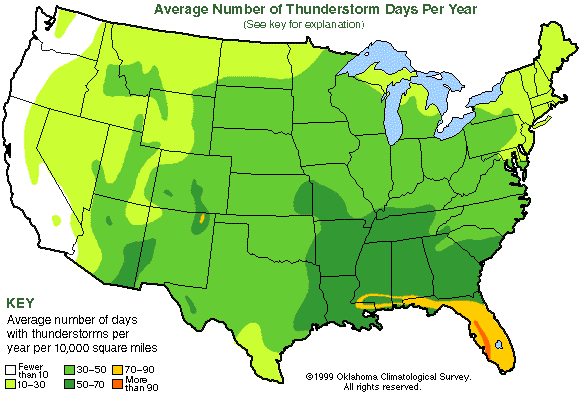 |
|
Figure 5:
The map above shows the frequency of thunderstorms across the United States.
Notice that the Gulf Coast and areas in the Rocky Mountains experience the
most thunderstorm days per year. |
Non-severe Thunderstorm Life Cycle
>> Typical lifespan of 1-2 hours
>> 3 stages in life cycle
There are three stages in the life
cycle of a non-severe thunderstorm. The first, the cumulus stage,
is marked by significant instability, adequate moisture and a lifting mechanism
which, together, work to produce an updraft. This updraft, in turn, causes
the cumulus clouds to grow progressively taller.
The second stage of the thunderstorm
life cycle is the mature stage. This is the stage in which precipitation
and lightning begin and both and updraft and downdraft are present. During
this time, the updraft has become strong enough that it reaches heights where
the temperature is far below freezing. This, in turn, allows the Bergeron-Findeisen
process to begin to produce precipitation. As mentioned earlier, the
production of precipitation leads to charge separation within the cloud and,
therefore, lightning.
Another important result of the
formation of precipitation is the production of the thunderstorm downdraft.
The falling ice crystals and rain drag air down with them, forming the downdraft
of the thunderstorm. This descending air becomes cooler than the
surroundings as the raindrops and ice crystals evaporate as they fall through
the atmosphere below the cloud. Once the air from the downdraft reaches the ground, it
starts to spread out horizontally and forms a gust front. New
thunderstorms may form along this gust front.
During the last stage of the thunderstorm
life cycle, the dissipating stage, the downdraft begins to dominate the entire
cloud as it "rains itself out." The domination of the downdraft in the
thunderstorm causes the updraft the cease and the convection to collapse.
As the convection collapses, dry air is entrained from outside of the cloud and
eventually causes the cloud to evaporate. All three stages of the
thunderstorm life cycle can be seen in Figure 6 below.
|
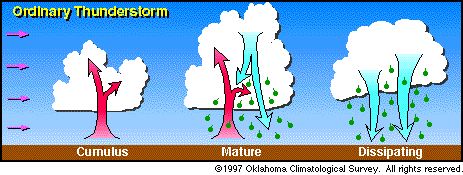 |
|
Figure 6:
The image above illustrates the three stages in the life cycle of an
ordinary thunderstorm. |
|